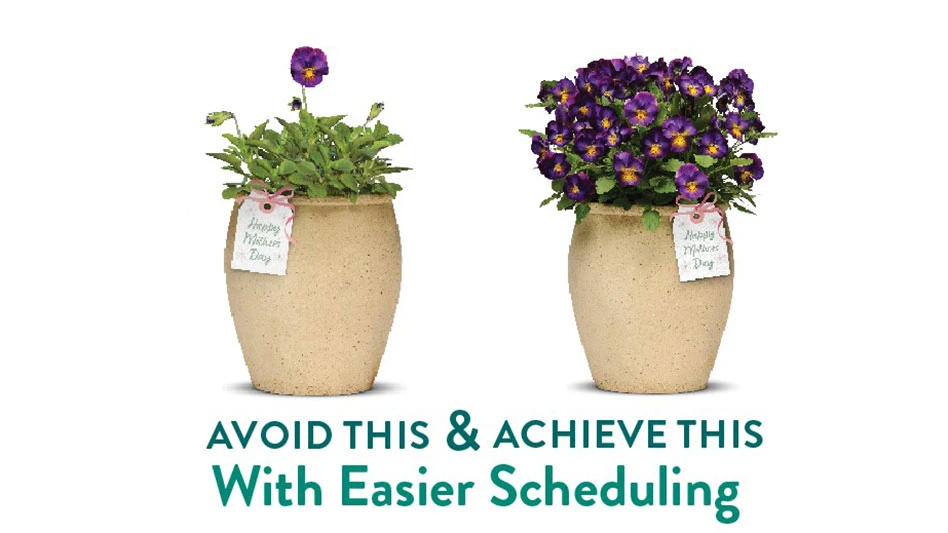

Accurate Perennial Scheduling Matters
For the longest time, growers have feared taking on Perennial crops due to the perceived challenges around production and scheduling. There are concerns about the requirements that are needed for some varieties to even bloom, such as bulking, vernalization and light accumulation. Many of your standard and older genetics require vernalization, which also can be intimidating. What does it even mean? How cold does it have to get to be impactful? How much time is needed? Besides the production practices, the scheduling for vernalization-requiring crops needs to focus on early blooming plants that need to bulk up the year before. A few notable examples are Armeria, Iberis, Phlox divericata, and Phlox subulata.
Some crops technically don’t need to be vernalized, but many growers insist on bulking them up the year before. These are generally your older varieties that don’t naturally bulk up. These would include Salvia May Night, Phlox paniculata Laura and Echinacea Magnus.
Still, there are other crops that have a natural bloom time in June or July when the daylight hours are longer. If you want to get them into bloom for early June when your sales are the strongest, you will need to apply nighttime light interruption. Notable mentions here are Echinacea, Monarda and Phlox.

“I’ve been scheduling perennials for nearly 30 years. This tool is by far the easiest way to do both seed and vegetative at the same time. It saves so much time! This makes it so much easier to have perennials in color when customers want them.” –Chris Fifo, Technical Representative, Darwin Perennials and Kieft Seed
Key questions you'll want answered as you get started are:
- Is the variety first-year-flowering or vernalization required?
- Will I be doing vegetative propagation, seed germination or ordering liners/plugs?
- Is this plant long day obligate?
There are several key resources you can leverage to answer these questions. Each breeder will likely have detailed culture for all of their varieties. Note that you will likely have a different breeder for seed and vegetative. For the non-patented varieties, many universities have quite a bit of perennial production research available. If you are ordering liners/plugs, sometimes your supplier will also have some in-depth production information. A ton of information is easily accessible, but it can be a bit daunting, especially if you’re starting over or anew.



Simplifying Perennial Scheduling
Darwin Perennials® and Kieft Seed™, owned by Ball Horticultural Company, align on certain values that work to a grower’s advantage. Simply put, they want to solve challenges with solution-oriented genetics, and they want to make production simpler. To fulfill this goal, much of their breeding is in first-year-flowering perennials. This means they are selecting plants that don’t require vernalization to flower, and that naturally bulk up quickly. The other focus is on extensive trialing to ensure the plants do what they are supposed to do, and on recording results to provide growers with the exact culture and production to make perennials straightforward to produce.
Darwin Perennials conducts extensive trialing and culture research at their facility in West Grove, PA. They have trialed over 170 varieties to date, with four culture trials throughout the season to identify how scheduling changes from early Spring through late Fall. Kieft Seed runs similar trials at their Elburn, IL, trial site, and have tested approximately 100 varieties with similar trialing practices. Combined with Chris Fifo’s technical expertise, we can offer the industry’s first ever seed and vegetative perennial collaboration to provide the growing details to growers.
Making the Process Easy
Our industry has not made the scheduling process simple. “When I first started at Darwin Perennials, we tried to have a powerful Excel sheet like others,” says Seth Reed, Marketing Manager. “The natural limitations of the tool proved to create too many issues for us.”
It was important to make the scheduling and culture information easily accessible, easy to use, easy to keep up to date with the latest varieties and research, and easy to communicate as information is created. That’s the reasoning behind the creation of the interactive website firstyearfloweringtool.com. On this site, all you need to plug in is your desired finish date and the tool does the rest.

Explore the March 2023 Issue
Check out more from this issue and find your next story to read.
Latest from Greenhouse Management
- Anthura acquires Bromelia assets from Corn. Bak in Netherlands
- Top 10 stories for National Poinsettia Day
- Langendoen Mechanical hosts open house to showcase new greenhouse build
- Conor Foy joins EHR's national sales team
- Pantone announces its 2026 Color of the Year
- Syngenta granted federal registration for Trefinti nematicide/fungicide in ornamental market
- A legacy of influence
- HILA 2025 video highlights: John Gaydos of Proven Winners





